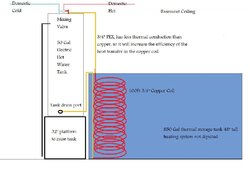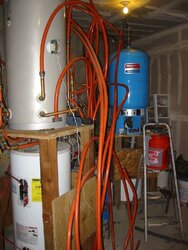So I appoligize for my endless posts on theoretical designs, but I think have thought of a good solution for my system when I finally build everything here in a few months.
Can I thermosyphon from an elevated hot water tank into a DHW coil in my thermal storage tank?
With the clearances I have in my basement can raise an electric hot water tank up off the floor 32", then out of the bottom port of the hot water tank put a 100ft 3/4 copper coil into my storage tank. As the water in the coil heats it will convect upward and enter into the top of the hot water tank. This design would allow me to use a conventional Electric tank that are really cheap, heat my DHW without any power, and save money on installing an additional circulator pump and controls for it. My next question is are there any restrictions in using oxygen Barrier PEX for some of the domestic water plumbing, or is there some chemicals in it that are not safe for drinking water? I am asking because will have some lines in potentially 180deg water that non barrier PEX wont be able to handle, and I want to be able to use the difference in thermal transfer between PEX to copper to my advantage.
I think the advantages of this system are simplicity, and potentially alot higher, and efficient transfer rate than a side arm, and alot cheaper than a $1000 indirect hot water tank plumbed in as a zone.
I will start drawing a diagram, but what do you guys think?
Can I thermosyphon from an elevated hot water tank into a DHW coil in my thermal storage tank?
With the clearances I have in my basement can raise an electric hot water tank up off the floor 32", then out of the bottom port of the hot water tank put a 100ft 3/4 copper coil into my storage tank. As the water in the coil heats it will convect upward and enter into the top of the hot water tank. This design would allow me to use a conventional Electric tank that are really cheap, heat my DHW without any power, and save money on installing an additional circulator pump and controls for it. My next question is are there any restrictions in using oxygen Barrier PEX for some of the domestic water plumbing, or is there some chemicals in it that are not safe for drinking water? I am asking because will have some lines in potentially 180deg water that non barrier PEX wont be able to handle, and I want to be able to use the difference in thermal transfer between PEX to copper to my advantage.
I think the advantages of this system are simplicity, and potentially alot higher, and efficient transfer rate than a side arm, and alot cheaper than a $1000 indirect hot water tank plumbed in as a zone.
I will start drawing a diagram, but what do you guys think?



